Hawaii's history is so long and mystical, that the date of its first settlement is greatly debated to this day — some say the settlers first came to the islands as early as 124 CE, while others have debunked this, stating it was closer to the year 1025. And, if you believe the stories of mythical creatures on the islands of Hawaii, you may think it was even earlier than evidence shows. From the Polynesian settlement to the unification of Hawaii's people to legends that are still shared today, Hawaii is rich with charm and intriguing mystery.
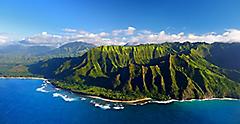
Hawaii's Storied History, Uncover The Mystery
What Is Hawaii's Historical Background?
The history and culture of Hawaii are storied, mystical and start centuries ago with volcanic hot spots in the Pacific Ocean. These volcanoes erupted to create a chain of islands from the ensuing lava in the middle of the sea. Transpacific voyagers sailed there, arriving from the Marquesas and Tahiti. It's said they used only the stars and their exceptional navigational skills to guide them. As these early explorers landed, they brought with them bananas, coconuts, sweet potatoes, taro, breadfruit, pigs, chickens and dogs — everything needed to build a society, and survive.
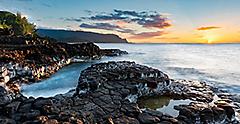
These societies were later invaded by warriors, who brought the idea of a caste-based social system to the islands, known as a Kapu system — kapu meaning sacred. The Kapu system became a way of life for the natives, serving as their set of sacred laws that may never be broken. Each society was ruled by its own chief, known as an ali'i, who upheld these laws. It was a common belief that the chiefs were direct links to the gods, so people respected them, which enabled them to have complete rule over the islands. Religion is what held these societies together, and it affected every aspect of the ancient Hawaiians' lifestyle, even food and drink were seen as godly.
Soon the system began to wear down, and wars broke out as chiefs fought each other for rule over more territories, resulting in nearly 100 years of wars for complete control of the islands and the entire Hawaiian archipelago. It wasn't until much later that there would be peace between the islands.
Today, 137 islands are officially recognized by the state of Hawaii, including small, uninhabited islets, atolls, and coral reefs. If you've ever been to this corner of the North Pacific, you likely started on the "Big Island" of Hawaii to the south, while there are seven other well-known islands: Oahu, Maui, Kauai, Lanai, Molokai, Kahoolawe and Niihau. Due to its ancient history, and their dedication to honoring the past, each island has its own unique culture.

Who Was Hawaii’s First King?
When Halley's comet zipped across Hawaiian skies in 1758, it held great significance to the people of Hawaii. First, this was no small feat, considering you can only see it once every 75 years. But this occurrence was particularly important to the Hawaiians because they believed in a prophecy that a child born during the comet's passing would one day rise to become a great leader, bringing peace to the islands.
This child, born under the comet in the Kohala District of the Big Island, became known as King Kamehameha The Great. He did what many could not — unify an island kingdom out of various tribes, warring in part because the original navigators who settled Hawaii each had their own chief. This proved difficult in terms of governance in the years to come, and it took arduous negotiations. Kauai's ruling chief finally agreed to accept King Kamehameha's rule, leading to battles with other tribes to ultimately unite the once warring chiefs.
As the first King of Hawaii, he brought peace to the islands, and in appreciation of this leader's intelligence and vision, today the people of Hawaii celebrate him on June 12, King Kamehameha Day. People gather around the King Kamehameha statue at Ali'iōlani Hale in downtown Honolulu and drape fragrant plumeria flower leis on the outstretched arms of the statue. There's music, pageantry, and, of course, hula dancing on that day to remember Hawaii's beloved king.
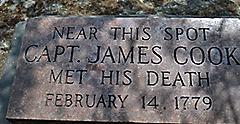
Influences On Island Culture & Westernized Hawaii
Today, Hawaii is a melting pot, a haven of diversity, which is apparent in its culture, cuisine and languages. But prior to King Kamehameha's unification of Hawaii, the islands were literally put on the map by the English Royal Navy Captain James Cook. By 1778, Cook had landed on the island of Kauai, at Waimea Bay, making him the first European to do so. He named the archipelago the "Sandwich Islands" after his patron, the Earl of Sandwich.
It was on his third trip there, however, that Cook made a fatal error in judgment. On February 14, 1779, one year after his first visit, Cook tried to kidnap the island's ruling chief, Kalaniʻōpuʻu, in exchange for a stolen longboat. This led to a skirmish, resulting in his death at Kealakekua Bay at the hand of Hawaiian natives.
This chain of events led to western ideas being integrated into the kingdom thanks, in part, to missionaries who arrived in the 1800s, coupled with the rise of the whaling industry, which was a big part of the region's economy at the time, and the influx of international businessmen who started pineapple, sugar and sandalwood plantations. Laborers from the Philippines, Japan and China all made their way to Hawaii to work in agriculture.

Enduring Hawaiian Legends And Traditions
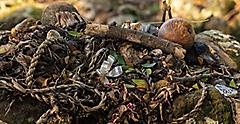
Folklore, myths, and traditions are still alive and well in Hawaii today. Legend has it that when settlers came to Hawaii, they were surprised to find that the islands were already inhabited by the Menehune. When the settlers landed there, the Menehune immediately fled into the deep, remote valleys. Menehune are known as industrious, mischievous, powerful "little people" who roam the islands at night and are rarely ever seen by human eyes, and that's just how they like it. Children in Hawaii grow up with tales of the Menehune, and are told that if you stay really quiet, you can hear them scurrying through the forest. Some even believe the Menehune are magical and will grant wishes, similar to leprechauns. I learned about the Menehune when visiting Maui with my mom, who was smitten by the idea of their existence, though I was dubious.
On the way home after a long day of being immersed in Hawaiian history, my mom and I stopped to walk along a beach during a brilliant sunset. All of a sudden, my mom called out to the Menehune, imploring them to show her proof of their existence. As a young 20-something, I was mortified by this! My mom, who quickly realized the level of my embarrassment, began shouting to the waves and the wind "Menehune, Menehune, Menehune, come here Menehune!" beckoning the Menehune to come out of hiding. For good measure, she added, "Send me some luck, or money!"
Red with embarrassment, I begged my mom to stop."You're being ridiculous! They. Do. Not. Exist," I said. In that moment, a wave washed up at our feet, carrying a crumpled twenty-dollar bill, as if it was expressly delivered by some mischievous force. "A-ha! Thank you Menehune!" my mom shouted with child-like joy, unfurling her water-logged bill in triumph and taunting me with her mystical treasure. I just stood there in dumbstruck disbelief. Could it have just been some coincidence or a cosmic sign that the Menehune are really out there? To this day, I'm not so sure.
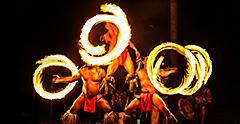
Long-Celebrated Hawaiian Traditions & Rituals
What I was sure of, however, was the ultimate must-do Hawaiian experience — the luau. The luau is an ancient tradition with Polynesian roots that is a celebration of community, often held to commemorate special events. Luaus were originally called 'aha'aina, or "gathering meal," where people would come together to feast on a variety of cultural dishes, alongside some traditional song and dance. Luaus were a place to have fun, but they also had strict rules; only a specific kind of food could be served, men and women could not eat at the same table, and certain foods were reserved only for the chiefs. These restrictions were ended in 1819 with a symbolic gesture by King Kamehameha II. He bucked the old traditions and held a luau where he shared the table with women and common folk alike, and thus the luau that is known and celebrated today was born.
I could not wait to attend my first luau. On the way there, we chatted up our bus driver, an older man who had lived on the island his whole life. He explained that he's part native Hawaiian, Welsh, German, Chinese and French. "Us Hawaiians are a mix of the whole world!" he proudly told us. "We're all connected, all "ohana," one family," he said. I quite liked this sentiment, too.
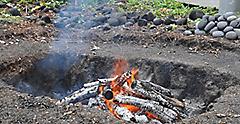
At the center of the lavish luau was a large table, with the most magnificent spread of colorful foods. We feasted among friends on shredded pork prepared in an imu (an underground oven), with pounded, starchy taro root called poi as a side dish, the aforementioned poke, and my favorite, haupia, a sturdy, jelly-like coconut pudding for dessert. It's decadent and delicious, but don't overdo it. I was warned: Eat too much of this treat, and you've got one of nature's best laxatives!
After the feast, the event becomes an all-out party. Hula, as I learned, is much more than just a beautiful dance of gracefully swaying hands and lithe women dressed in grass skirts and leis. Prior to the 1820s, before missionaries came to the islands and introduced a Latin-based alphabet, Hawaiians passed on their history and culture to the next generation by storytelling through song, hula, and chants known as oli, which Hawaiians believe carry spiritual energy. While my mom and I had so much fun learning how to hula, we also discovered the deeper meaning behind it. This tradition connects present-day Hawaiians to their ancestors. Some dances are slow and sorrowful, others vibrant and fast-paced — always with a nod to Hawaii's colorful past and its connection to the present, and to the people who call these islands home.
Get Royal Deals, Sign Up Today

Getting There
Explore Our Most Affordable Itineraries
Discover the culture of Hawaii and its island folklores on your cruise vacation.





